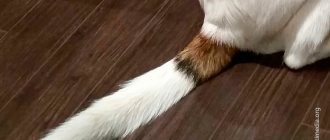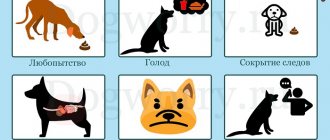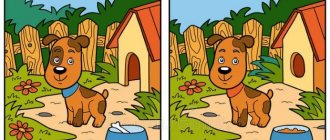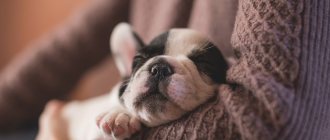Changing an old fur coat is considered a mandatory and natural occurrence in the life of a four-legged friend of any age, size and breed. Upon completion of molting, your pet's fur coat looks soft, shiny and silky. It is important for the owner to understand when the process is a natural necessity, and when it arises due to malfunctions in the animal’s body.
Why do dogs shed and how does it happen?
By appearance you can judge the physiological health of your four-legged friend. A soft, shiny, silky coat is evidence of the good functioning of the dog’s internal organs. But the hanging shreds cause a feeling of anxiety about his condition.
The natural shedding period in dogs begins in response to changes in external temperature and daylight hours. At this time, the pet produces an increased amount of the hormone melatonin, which is responsible for the thickness of the coat. The process of coat change is seasonal and lasts 2-3 weeks. During this time, the dog loses the old undercoat and guard hairs, in return growing new ones - more suitable for the current season.
Causes of hair loss in dogs
A dog's fur is an important protective barrier. It saves you during cold weather and winds and prevents you from getting too wet. Hair protects against certain parasites and infections. It also saves from minor injuries - light scratches, cuts, bites, and softens bruises.
In sick animals, the condition of the coat also worsens. It fades, thins, becomes oily or, on the contrary, dry to the touch, brittle, and rolls off.
To understand whether hair loss in a pet is physiological or caused by disease, you need to know when shedding occurs in dogs. Healthy animals shed regularly. This occurs with changes in the length of daylight hours.
spring molting begins . During this period, the warm, thick undercoat falls out en masse, and the dog prepares for the heat. When the length of the day begins to decline, the autumn coat change begins. Then, on the contrary, the number of coarse guard hairs decreases and the insulating undercoat grows.
In addition to seasonal molting, females often undergo this process also before estrus, during pregnancy and feeding their offspring. This is due to hormonal fluctuations in the body.
Hair loss can occur due to stress, unbalanced nutrition, and infectious diseases.
Types of shedding in dogs
The period when a four-legged friend is actively getting rid of hair is not the most pleasant time in the life of the owner and his family members. Pieces of wool scattered throughout the apartment do not decorate the home. However, we must understand that this is a natural process that ends quickly. The types of shedding in dogs also depend on living conditions.
Seasonal
The fur protects the four-legged friend from environmental conditions: in winter - from cold, in summer - from overheating. To this you can add additional protection against infections and parasites. The coat change, respectively, occurs in spring and autumn.
Before the onset of cold weather, the animal gains a thick undercoat to protect it from low temperatures. The duration of the period is longer, and the result is a voluminous, fluffy fur coat. Spring replacement is much more active and noticeable, because the clumps fall out in large quantities. On average this lasts a couple of weeks.
Extracurricular
Four-legged friends living in a house or apartment are most susceptible to replacing their coats out of season. They are very sensitive to temperature changes and increased dryness in the living room. For example, extracurricular shedding in dogs begins when the central heating is turned on or off. Sometimes cases of hair loss can be associated with stress, as well as pregnancy and lactation.
Pathological
Uneven shedding of hairs, the appearance of bald areas on the body, redness and inflamed areas of the skin are signs of illness in a pet. You should contact a veterinary clinic for advice. The specialist will conduct an examination, find out how long the dog’s shedding has been going on, take the necessary tests and prescribe treatment that will stop the pathological shedding of hair. The cause may be hormonal disorders, disruptions in the gastrointestinal tract, viruses, fungus or allergies.
Age
A decrease in the production of the hormone melatonin has a bad effect on the appearance of an elderly dog. Irreversible changes occur in the structure, thickness and natural shine of hairs.
Chronic diseases leave their mark on older individuals. Vitamin complexes prescribed by a veterinarian after examining the patient will help cope with increased hair loss.
What types of molts are there?
Depending on where the animal lives, there are several types of molting. Let's look at their differences and features.
Seasonal
The main function of wool is protection from climatic conditions. The cover retains heat in winter, and in summer it protects the dog’s skin from overheating. In addition, there are additional properties such as protection against parasites and infectious diseases.
Animals living in natural conditions, such as yard dogs, change their skins according to the seasons. In the spring - on a thinner one, in the fall - insulated.
In the winter, dogs don’t so much get rid of their fur as they gain undercoat, which warms them on cold nights. This kind of shedding lasts longer than the spring one, and as a result the dog can become more voluminous and fluffy.
In spring, the process of shedding hair is more active. The fur falls out quickly and in large quantities, forming balls that lie everywhere. The average duration is from a week to two depending on the time of year.
It is advisable to thoroughly comb your dog twice a day, especially in the spring, to prevent the formation of stray hairballs.
Off-season
Out-of-season hair loss is most common in pets. They are more sensitive to changes in the situation in the apartment and actively respond to it. For example, at the beginning of the heating season, a dog may begin to actively shed. There are frequent cases of hair loss during pregnancy and feeding of puppies.
If the molting process is delayed beyond normal, you should consult a doctor. The most striking reasons for examination:
- hair loss in clumps;
- the dog’s appearance is unkempt, its coat is dull;
- changes in hair thickness and structure;
- growth slowdown.
Age
Changes in the structure of the coat, its thickness and shine occur in older pets. This is due to many factors, chronic diseases and simply old age. In order to help the animal, they contact a veterinarian and, through treatment, replenish the substances missing in the body.
Painful
Uneven hair loss, the formation of bald patches on different parts of the body or on the head, inflammation and redness of the skin are symptoms of disease. They have nothing to do with natural processes and require medical intervention. Such cases are treated with special attention, and without wasting time, they take the dog to the clinic.
When and for how long does the coat change?
It is impossible to determine the exact date when dogs shed. Shedding is entirely dependent on environmental factors. If it warms up early outside, then the spring change of cover will begin earlier. A sharp and severe cold snap at the very beginning of autumn causes unscheduled preparations for winter. It is also necessary to take into account the characteristic features of representatives of different breeds, the conditions in which the dog is kept, its diet and activity.
Puppies' first molt
The first down replacement in babies begins at the age of 2-3 months. In German Shepherd and French Bulldog puppies, shedding occurs later, at 3-4 months.
Replacement with teenage wool for long-haired babies lasts quite a long time - on average up to 9-12 months. Short-haired babies acquire “adult” undercoat and guard hair by the age of one year.
Subsequent molts
When a dog sheds depends not only on the breed, but also on different living conditions. A four-legged friend who lives in a city apartment with a constant air temperature and a lot of artificial light can change his coat regardless of the time of year. In such circumstances, the process can last all year, but at the same time be weakly expressed.
When do dogs start shedding?
The first coat changes at the age of several weeks. At one and a half months of age, puppies acquire new hair, which is stronger and thicker than the one they had from birth. Some dog breeds change color, becoming lighter or darker.
The first molt begins on average at six months of age. For some pets it happens earlier, at 3–4 months, for some – later. Large breeds of dogs grow and develop longer than small ones, so the coat of such pets often begins to change later. During the first molt, the fur changes its characteristics - guard hair appears, the fur coat becomes tougher.
Depending on the breed, the complete formation of an adult coat in dogs takes different times. From several months to a year for some, from two to three years for others. During this period, color may change greatly.
The process of changing coats also occurs differently. Some dog breeds shed quickly, others take much longer.
The amount of hair lost can be small or, on the contrary, abundant.
A dog's autumn shedding , during which it grows a warm undercoat for the winter, usually begins in September. The down is more voluminous and thicker than the guard fur, and the pet visually enlarges and becomes softer to the touch.
The spring coat change usually takes place in May and lasts faster.
Feeding a dog during shedding
The pet does not experience health problems when it sheds, but sometimes its mood and appetite may worsen. During this period, you need to organize a healthy, balanced diet, provide your pet with the necessary amount of vitamins, proteins, carbohydrates and other important nutrients (vitamins for dogs against hair loss).
When feeding dry or canned food, pay attention to the instructions on the packaging. Suitable food for strengthening the coat and hypoallergenic. Cheap products should not be fed; the diet should be at least premium.
If your pet is used to eating natural food, it is important to provide enough meat. Turkey and rabbit fillets and offal are very healthy. Every week (1-2 times is enough) sea fish should be added to the diet.
They are thoroughly cleaned of bones beforehand and heat treated to avoid infestation by parasites.
Along with this, you can give nutritious cereals (millet, wheat, rice). We must not forget about fermented milk products (cottage cheese, kefir, yogurt).
With such a diet, vitamin mixtures must be added. A specialist will help you choose the right one. He will also calculate the daily dose and duration of the course.
Thanks to high-quality feeding, your pet will feel cheerful and cheerful, and the coat will be qualitatively replaced with a new, healthy and shiny one.
How to brush a dog when shedding
In order for your four-legged friend to look neat during a coat change, and also to reduce the amount of hair in the home, the dog must be combed. They use various tools and their combinations depending on the type of animal's fur.
A good result is obtained by using a furminator - a device that looks like a rake. For short-haired dogs, a tool with short teeth is suitable; for those with long fur, a tool with long teeth is suitable.
It is useful for the owner to have a slicker brush. This tool also comes in different sizes and features to suit each type of dog. With its help you can effectively get rid of excess thick undercoat. Brushes of different hardness and made from different materials are also used.
To combat tangles, use hard combs and combs. The strands are distributed with the same tools. Heavily matted hairballs that cannot be untangled cause discomfort to the animal. To solve the problem, they are carefully cut off with scissors or shaved. It is important to carry out such manipulations as carefully as possible so as not to damage the skin.
You can use special gloves or hand guards. In addition to removing dead hairs during combing, the pet also receives a pleasant, beneficial massage, which helps improve blood supply to the skin and the rapid growth of new beautiful fur.
Hair loss not associated with shedding
If there are no health problems, then the behavior of dogs when shedding remains unchanged. In case of prolonged change of coat, changes in characteristics (dull, brittle, dry or, on the contrary, oily, appearance of bald patches), it is worth contacting a veterinarian. This indicates pathology.
Such problems can arise due to vitamin deficiencies, poor nutrition, poor living conditions, allergies, stress, hormonal fluctuations, states of shock, internal diseases of various organs and systems, infection with parasites (internal, external), and various infections.
Often, simultaneously with this manifestation, other symptoms occur: lethargy or restlessness, itching, dandruff, skin inflammation, wounds.
It is important to make a timely diagnosis and begin appropriate treatment. To do this, they often resort to laboratory tests of fur and skin scrapings. Sometimes additional studies are prescribed.
The owner should remember that frequent bathing of the pet and the use of inappropriate cosmetics (human shampoos, care products unsuitable for a certain breed and age of the pet) also do not bring anything good. As a result, dandruff, dry and brittle hair, prolonged shedding and even dermatitis occur.
Features of shedding by breed
Different types of fur are characteristic of different animals. Their structure, density and length differ. Because of this, natural replacement occurs in different ways. Some people tend to shed a large number of clumps in a short period of time, for others everything happens slowly and for a long time.
In long-haired
Owners of long and medium fur coats need periodic combing, which prevents the appearance of tangles. In addition, long-haired representatives are washed using special shampoos with conditioner and masks.
Every owner knows what to do when shedding begins in long-haired dogs - he has already learned from his first experience. The difficulty in keeping dogs with such a fur coat lies in the need for constant cleaning during seasonal molting. Furry animals include collie, sheltie, spaniel, Pekingese, Afghan hound, different types of shepherd dogs, Siberian husky and some others.
Often such breeds shed in patches - even with careful grooming, bald patches are visible on the panties or sides. But molting, fortunately, does not last too long.
In shorthaired
Smooth species, such as Rottweiler, Toy Terrier, Dachshund, Chihuahua, Pug, Bulldog and others, shed for a fairly long period. Their fur falls out unnoticed, but it is very difficult to remove. Only a vacuum cleaner can help remove short hair from carpeting or upholstered furniture.
In wire-haired
Representatives of miniature schnauzers, middle schnauzers, giant schnauzers, fox terriers, Airedale terriers and Scottish terriers are the easiest to care for. In dogs with coarse guard hairs, the undercoat does not change much. Accordingly, severe hair loss does not occur. Four-legged pets should be trimmed as necessary to remove dead particles.
Breeds that don't shed
For people who are susceptible to allergic reactions, only certain types of pets are suitable as pets. These include the Maltese, several varieties of poodles, Yorkshire terrier, Welsh terrier, border terrier, Bedlington terrier, wheaten terrier, Basenji, Xoloitzcuintle and some others. These dogs practically do not shed their hair and do not emit specific odors characteristic of the rest.
Dog shedding, why it stinks and what to do
Animal fur is short-lived.
In winter, the animal needs a warm coat, which is not necessary in summer, this is provided by nature. Due to the fact that one coat is replaced by another, the four-legged friend sheds, getting rid of excess hair and fluff in the summer.
A pet is in almost the same temperature conditions all year round. Because of this, the dog sheds regardless of the time of year. Wool constantly flies all over the apartment and can stink.
Wool has one property - it undergoes renewal 2 times a year.
In addition to seasonal shedding: in autumn and spring, pets can also experience out-of-season molts.
The frequency of hair loss can be influenced by your dog's health problems. If your pet is shedding very heavily, you should make an appointment with a specialist.
But we must not forget that you can help your four-legged friend at home.
Animal care
Loving owners should clearly understand what to do when a dog sheds heavily. This process causes discomfort not only for humans, but also for pets. To help your four-legged dog easily survive this period, you need to take seriously its diet, bathing, combing and other grooming procedures.
What tools and combs are needed
Devices for removing tangles and old fur from a pet are very diverse. Their choice depends on the type of coat of the dog and the nature of hair loss. Most often used:
- massage brush-mitten;
- slicker;
- a comb with sparse, curved teeth;
- furminator (brush with metal teeth);
- tangle cutter (for long-haired animals).
Before purchasing a suitable tool, it would be a good idea to consult with a pet store seller, a veterinarian, or an experienced owner of an animal of the same breed.
Combing algorithm and frequency
The most convenient method of removing dead hair is combing with special brushes or slickers. The latter are used if there are redness, wounds, or irritation on the body.
For proper combing, guide the brush strictly in the direction of hair growth, lightly pressing the tool. This should be done carefully so as not to cause pain.
The brush should go deep enough to pick up the old fur coat. The dogs are combed out gradually, with leisurely movements. The procedure is performed as needed, but during the shedding period for short-haired breeds it is 1 time per day, for long-haired breeds – 2 times a day.
Nutrition and vitamins
Nowadays, it will not be a problem to buy vitamins for dogs at any specialized pharmacy or pet store. Introducing them into food is useful not only during the season of changing processes, but also at normal times. Before purchasing, you should carefully study the composition, or even better, consult with a specialist. Drugs that improve hair growth include:
- Brewer's yeast;
- fish fat;
- vitamin B.
In order for the coat to be replaced quickly, it is necessary to provide the dog with the right food. Protein should predominate in the diet, which ensures shine, softness and strong hair structure. It is advisable to introduce high-quality meat products and offal into the diet, including raw ones.
Is bathing necessary?
To speed up the combing process, you can give your dog a bath. Here special pet shampoos with a high percentage of protein will come to the owner’s aid. After bathing, dead hairs will be better removed, as the process of pulling them out will be much easier. Frequent water treatments are not recommended at this time - some breeds do not need monthly bathing at all.
Special grooming procedures
Properly selected vitamin and mineral complexes and nutritional supplements can reduce the duration and intensity of the seasonal process. If they do not have a noticeable effect, you should consult a veterinarian. He will tell you what to do when your dog sheds heavily. You can also use grooming services.
Express molt
Professionally performed combing is called express shedding. It is carried out by a master in a hairdressing salon for animals, that is, in a grooming salon.
Express shedding includes brushing with a furminator brush, bathing with shampoo and conditioner, and drying with a special hairdryer. The procedure makes it possible to remove up to 90% of dead hair, and the effect lasts up to 3 months.
Trimming
Removing dead hair by plucking is called trimming. This is a health and hygiene procedure carried out in the salon. Trimming is recommended for wire-haired breeds (listed above), which find it difficult to shed dead particles on their own. A salon procedure is performed on average once a quarter, which allows you to maintain a neat appearance for your pet.
Prevention of off-season shedding
If your pet continues to shed for a long time and very heavily, then you should make sure that this is not a periodic phenomenon. As a rule, seasonal coat changes are not accompanied by skin irritations and bald patches.
It is important to know how many times a year the animal changes its coat. The first time this happens is in the fall, when the dog grows thicker and warmer fur before the winter cold, and the second time the dog changes its coat only in the spring.
Experienced breeders warn that in the wrong conditions the dog sheds all year round. What to do? Prevention of off-season molting includes the following measures:
- regular supply of fresh air;
- physical exercise;
- location of the dog's resting place away from heat sources.
It's no secret that pets who sleep and rest near heating appliances shed a lot. This should not be done under any circumstances, because the heat causes the dog’s skin to dry out and the hair begins to fall out.
And also do not forget to systematically ventilate the room where the animal is located. Cool air lowers the temperature in the room and helps the dog not overheat. Physical activity plays a huge role in maintaining a dog’s health - walk with your pet every day, involve it in active games, the pet should experience new emotions and enjoy life.
A specialist will tell you why your dog sheds a lot. If she has lost weight or scratches the affected areas, the risk of developing serious illnesses should be excluded. As a rule, a healthy animal that spends a lot of time in the fresh air sheds no more than 2 times a year, and a coat change takes on average 14 days.
Why does a dog shed for a long time and heavily?
A pet's appearance is a reflection of its health status. Therefore, any abnormal or extraordinary shedding becomes a serious cause for concern and a visit to the veterinarian. The cause of the problem is:
- hormonal disbalance;
- the presence of skin or intestinal parasites;
- infectious diseases;
- skin diseases;
- disturbances in the gastrointestinal tract;
- improper feeding;
- food allergies.
Only a veterinarian can help find out the cause and save the four-legged from inconvenience. Examination of the patient, taking the necessary tests, and a detailed conversation with the owner will allow you to prescribe optimal treatment or give recommendations.
Sometimes seasonal molting is delayed due to living in an apartment with intense heating. In this case, you should walk your dog more often and for longer, and also ask the veterinarian to prescribe good dietary supplements and vitamins.










